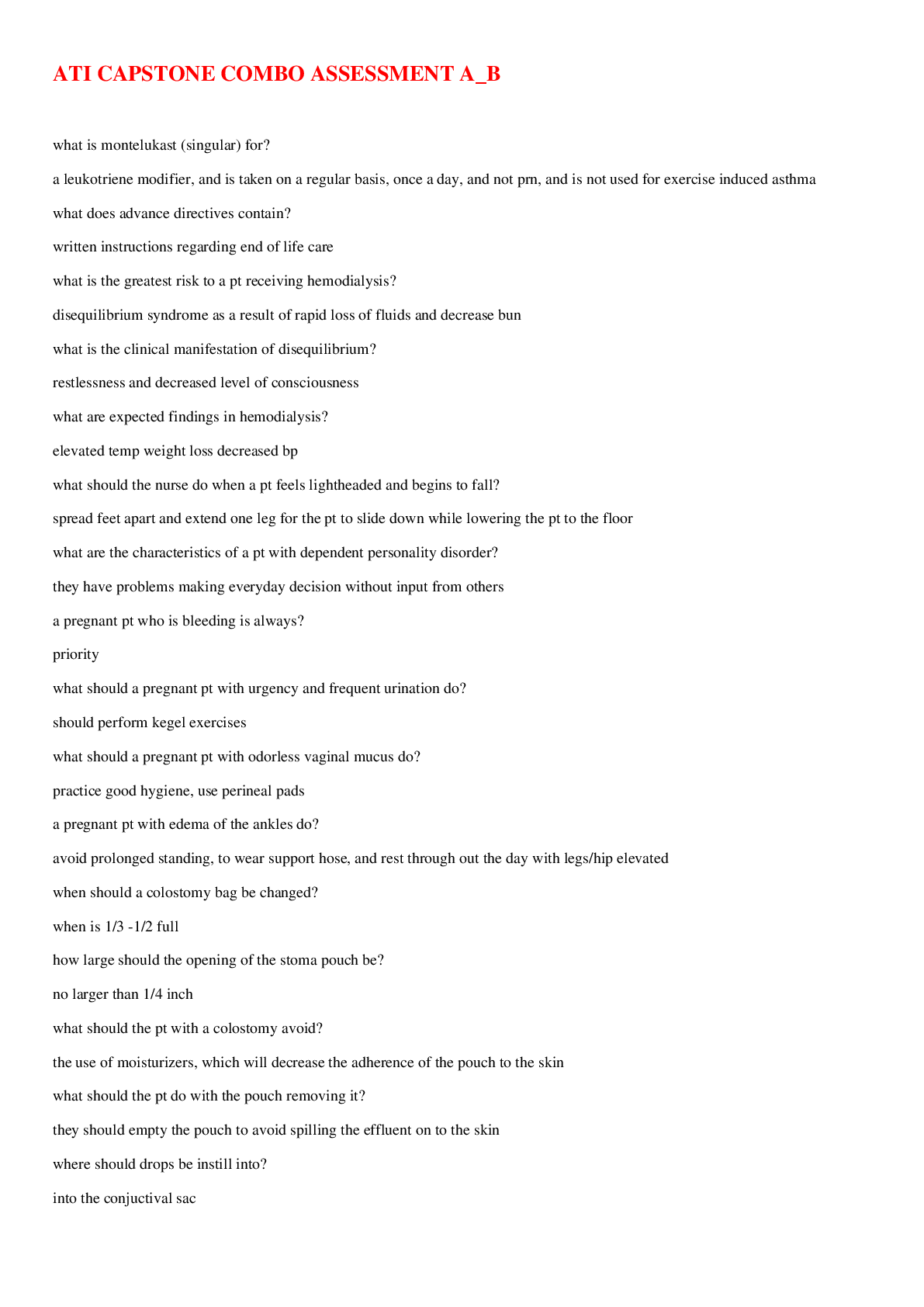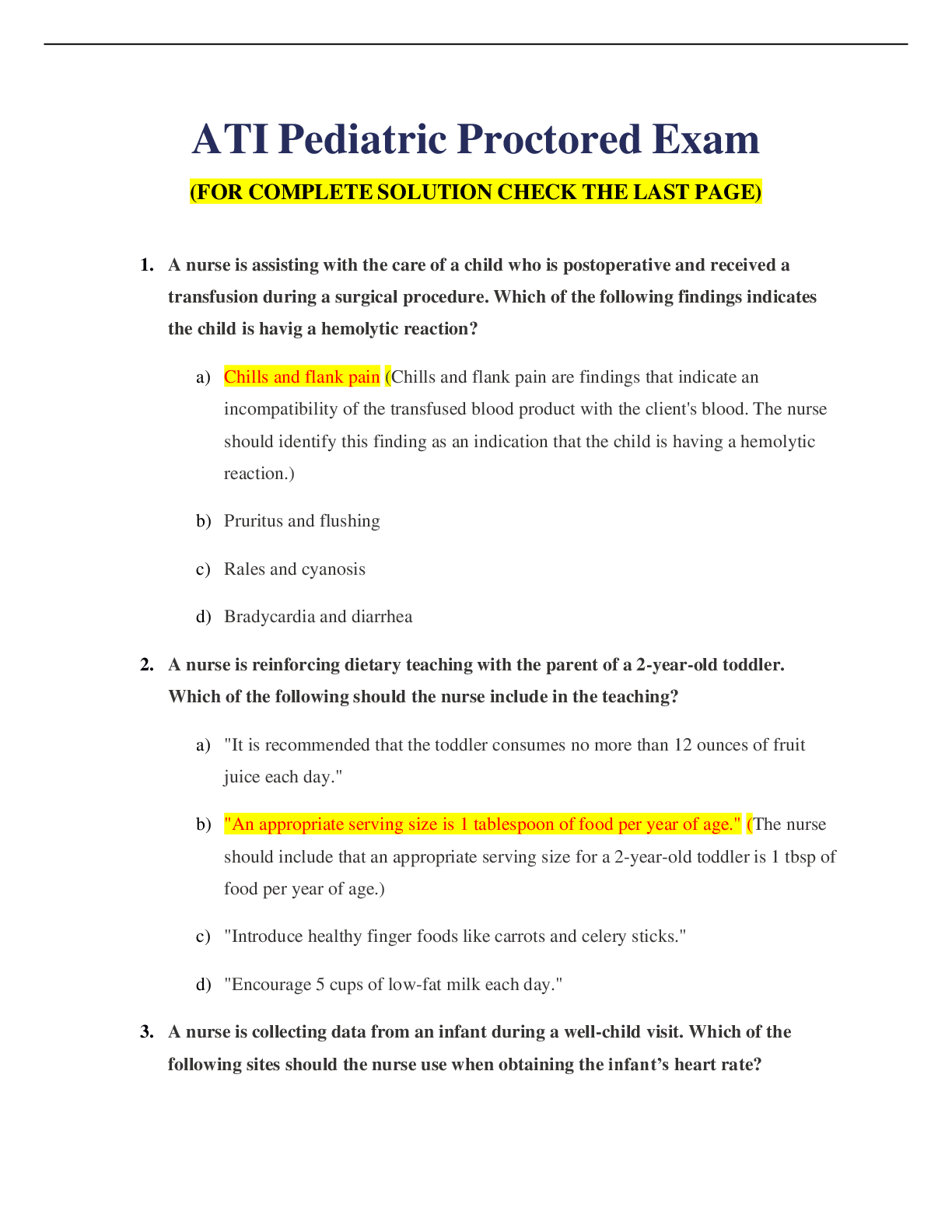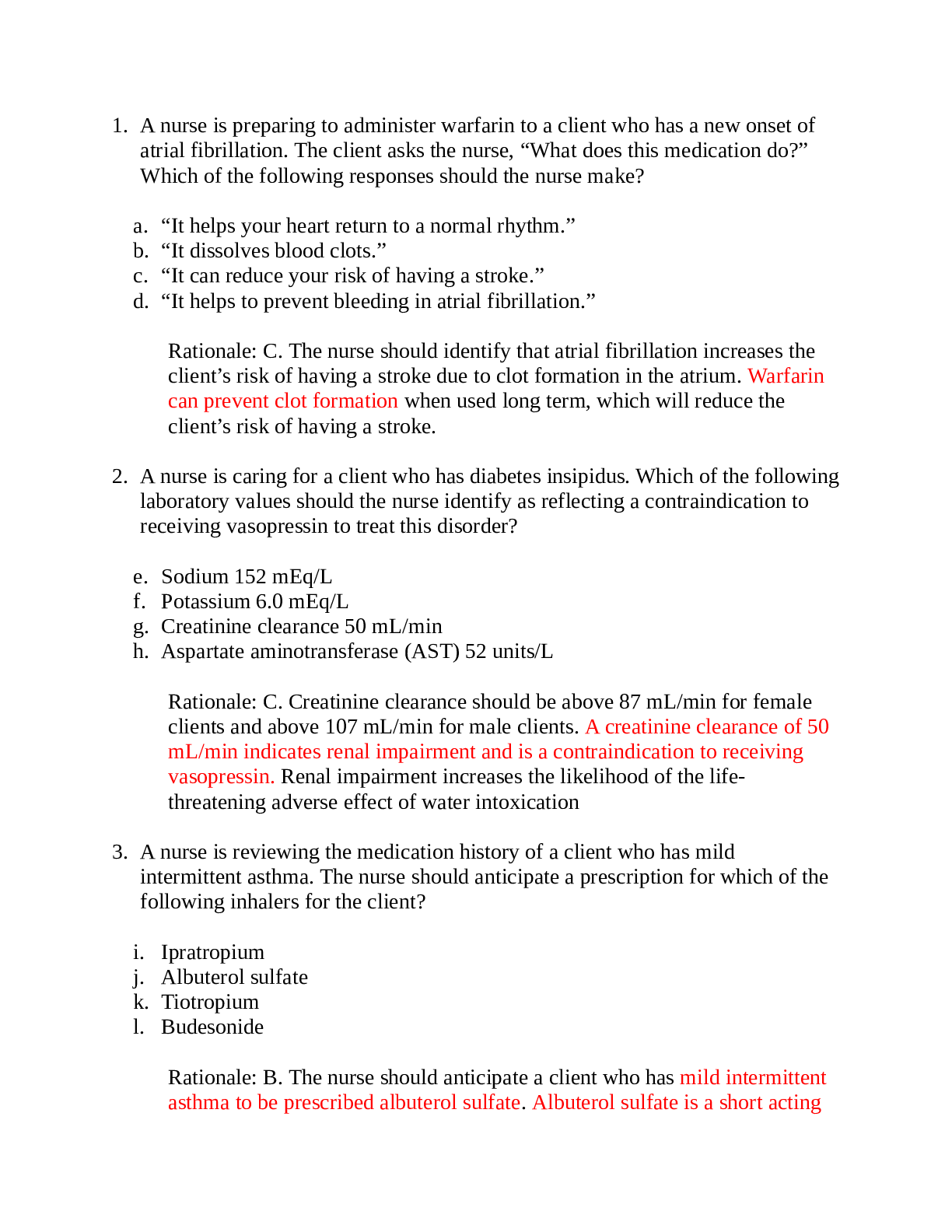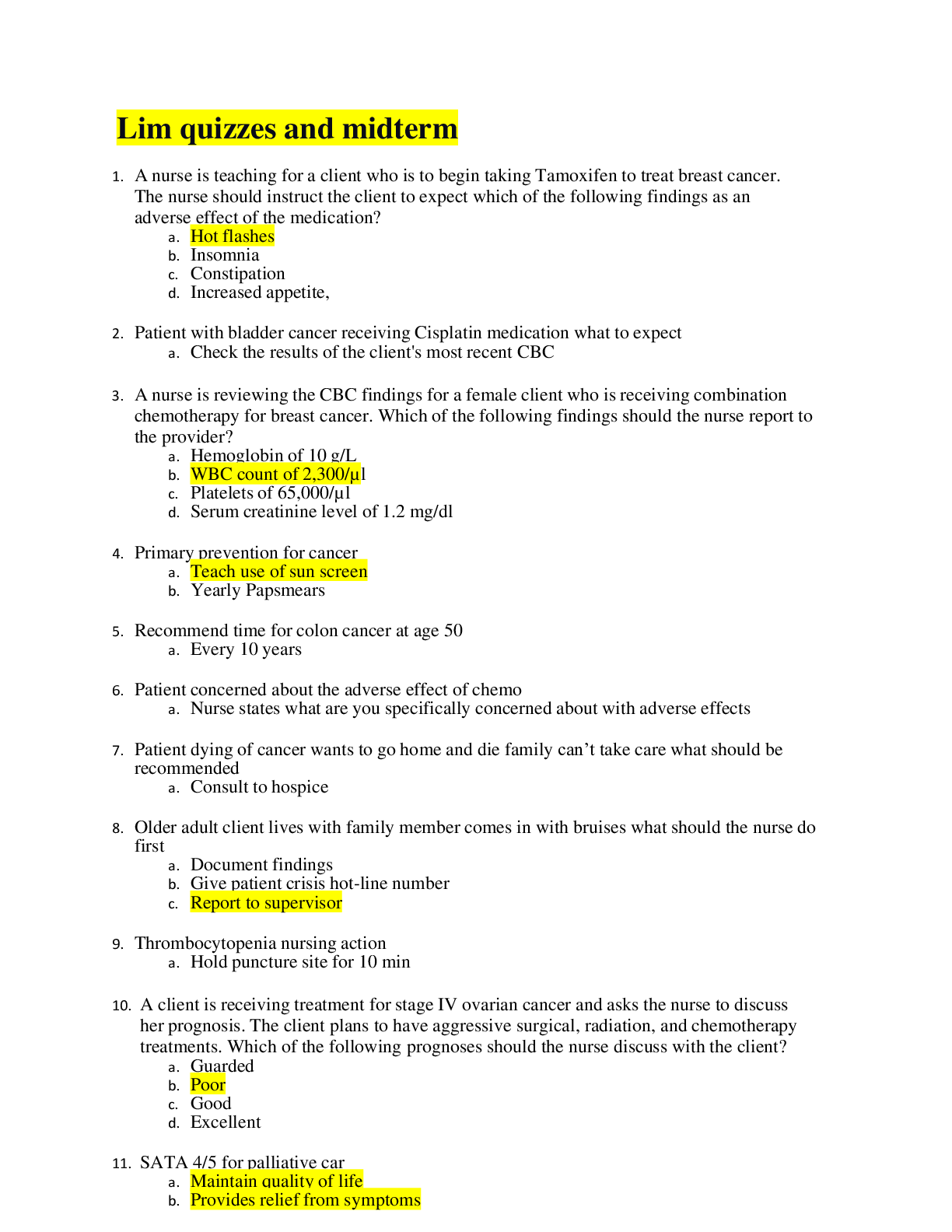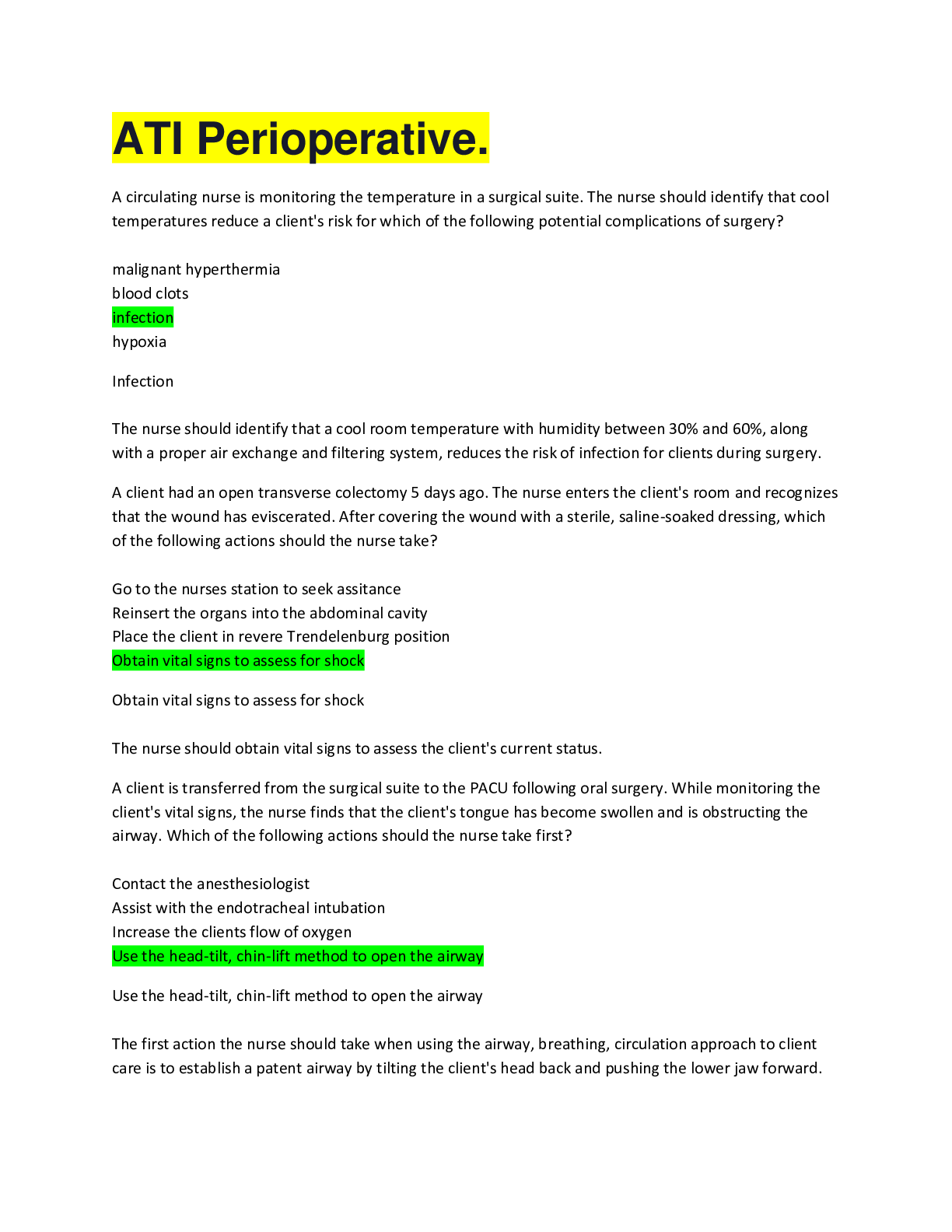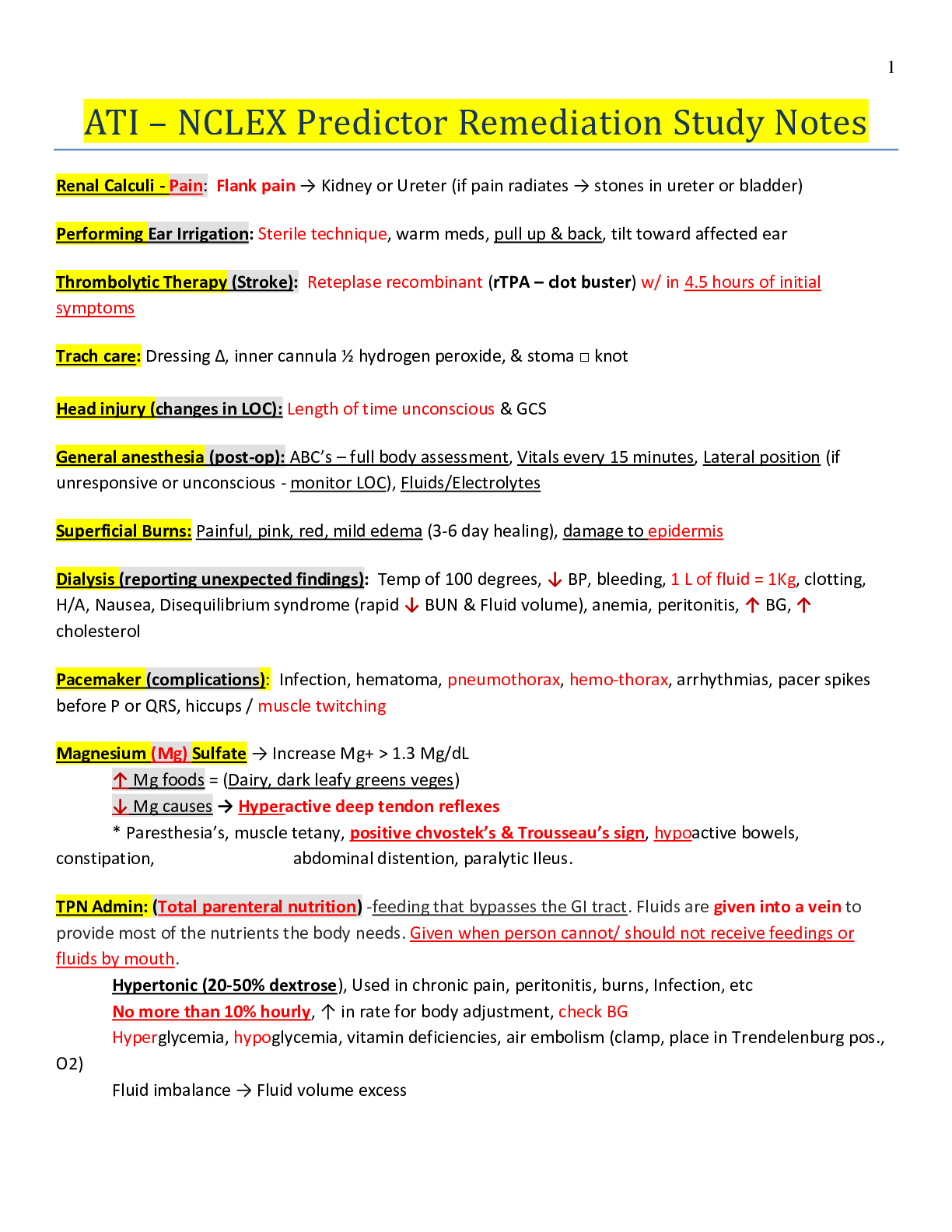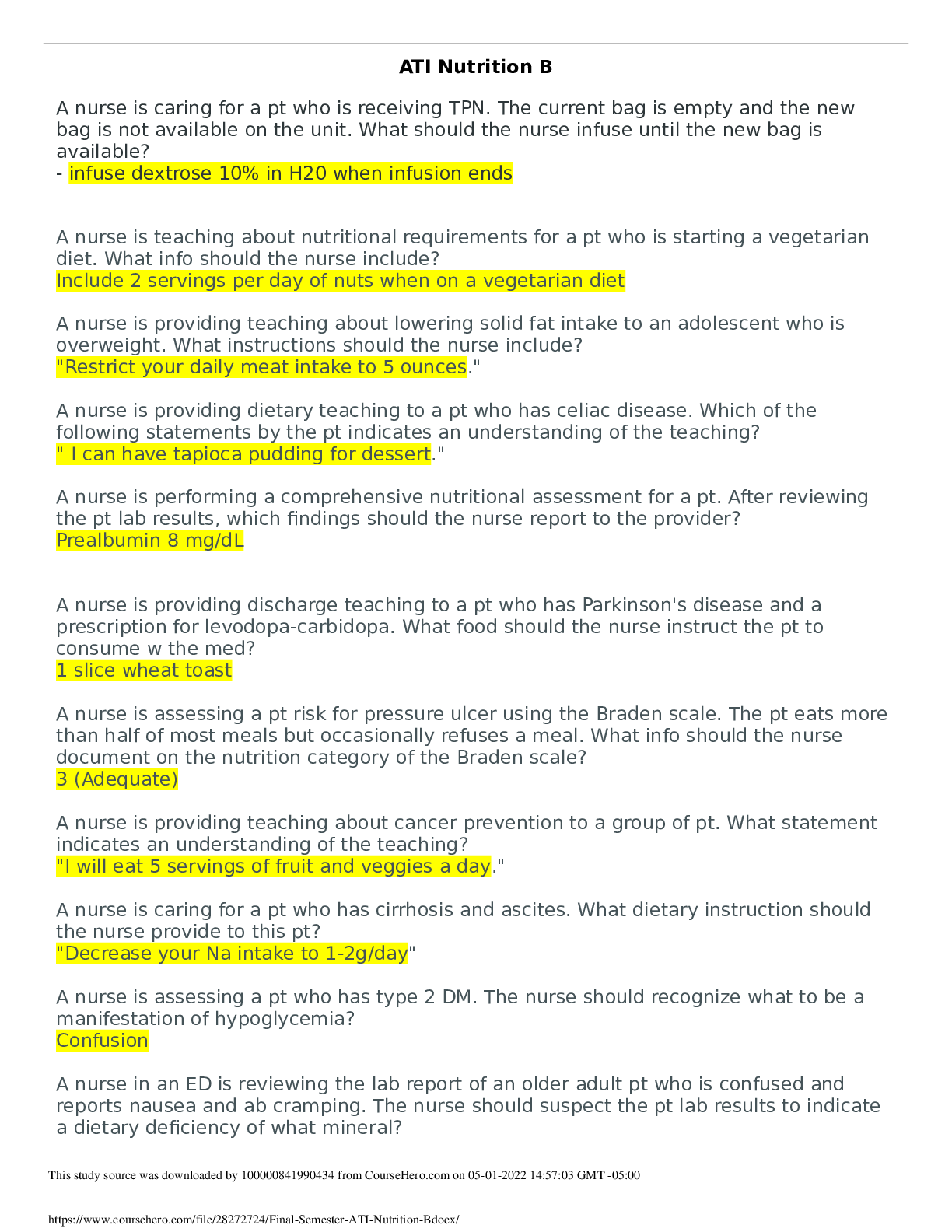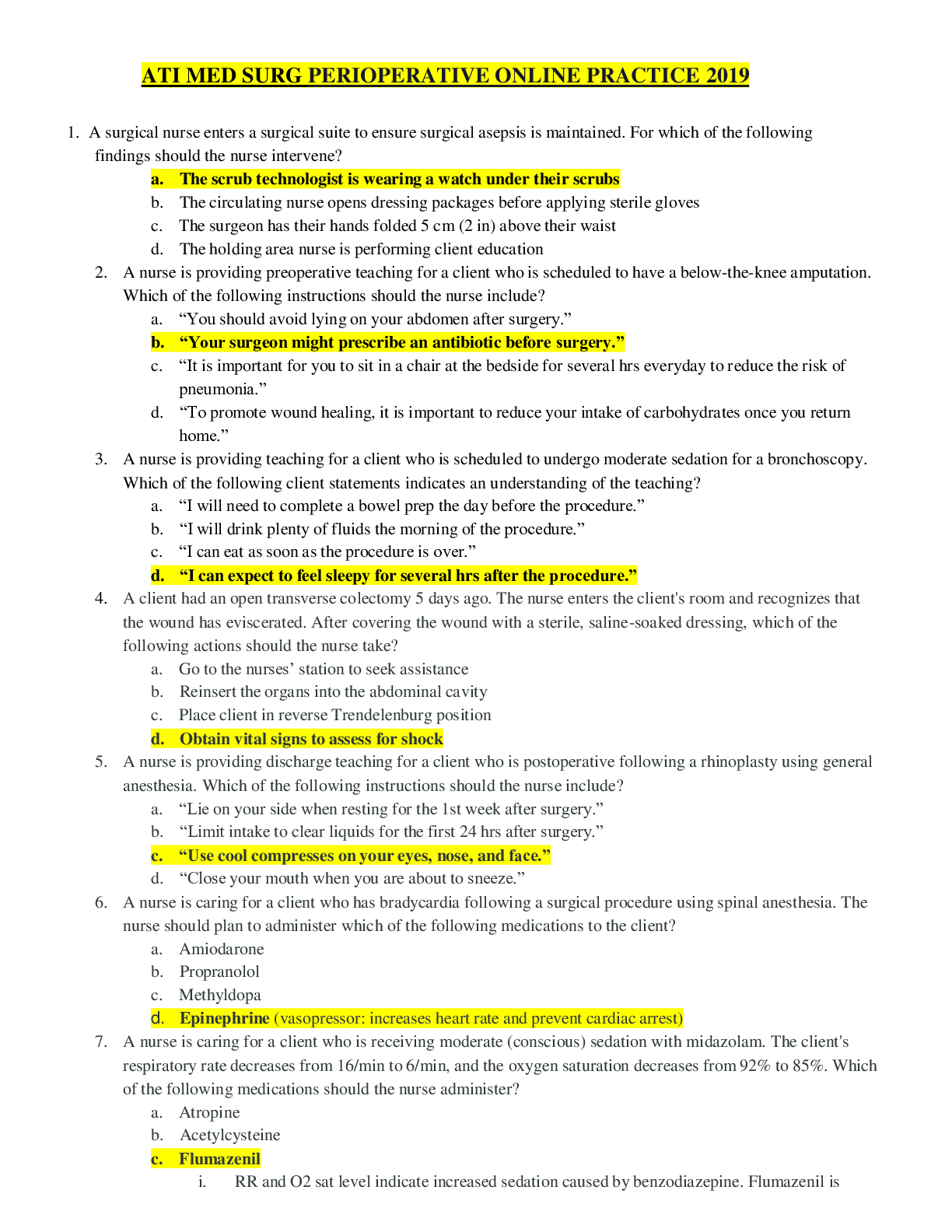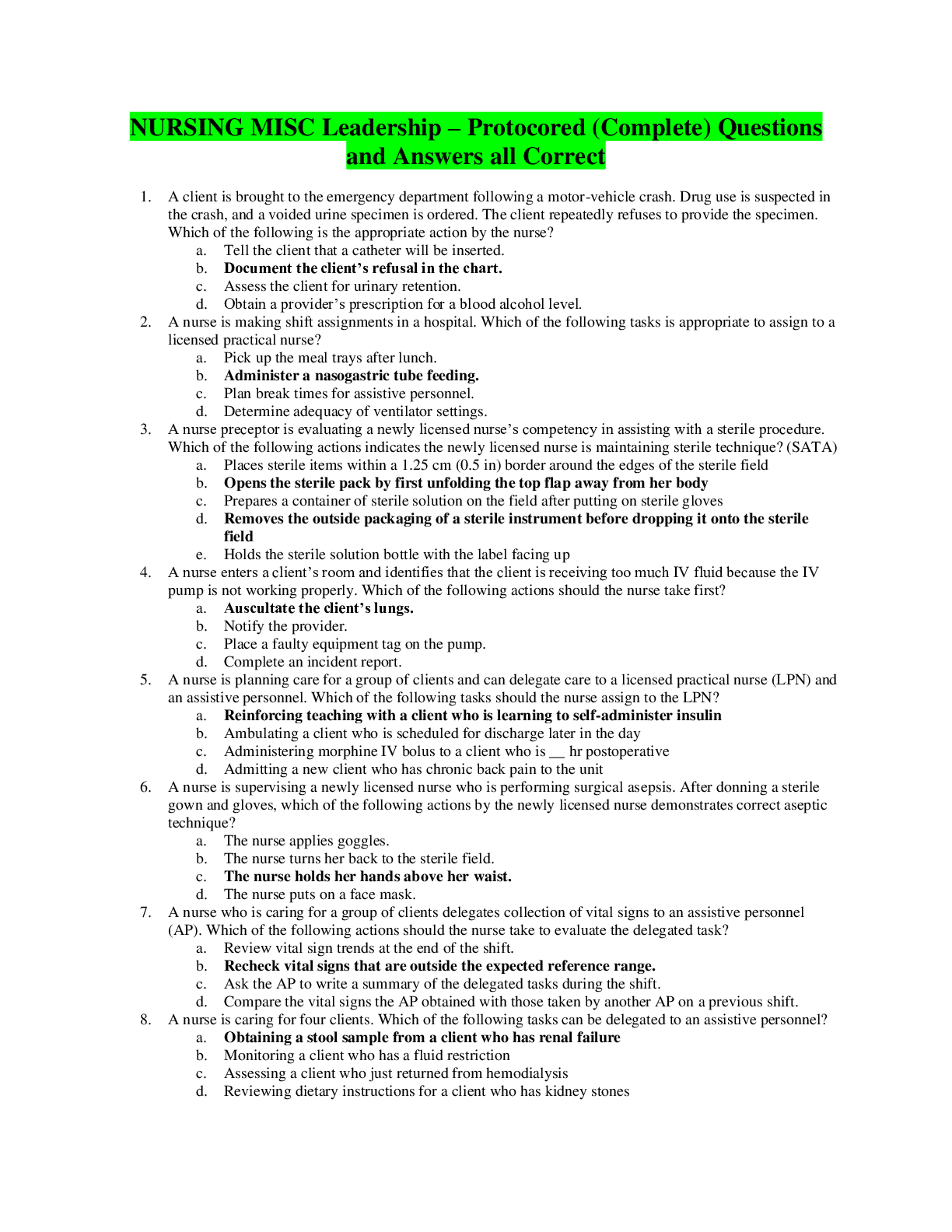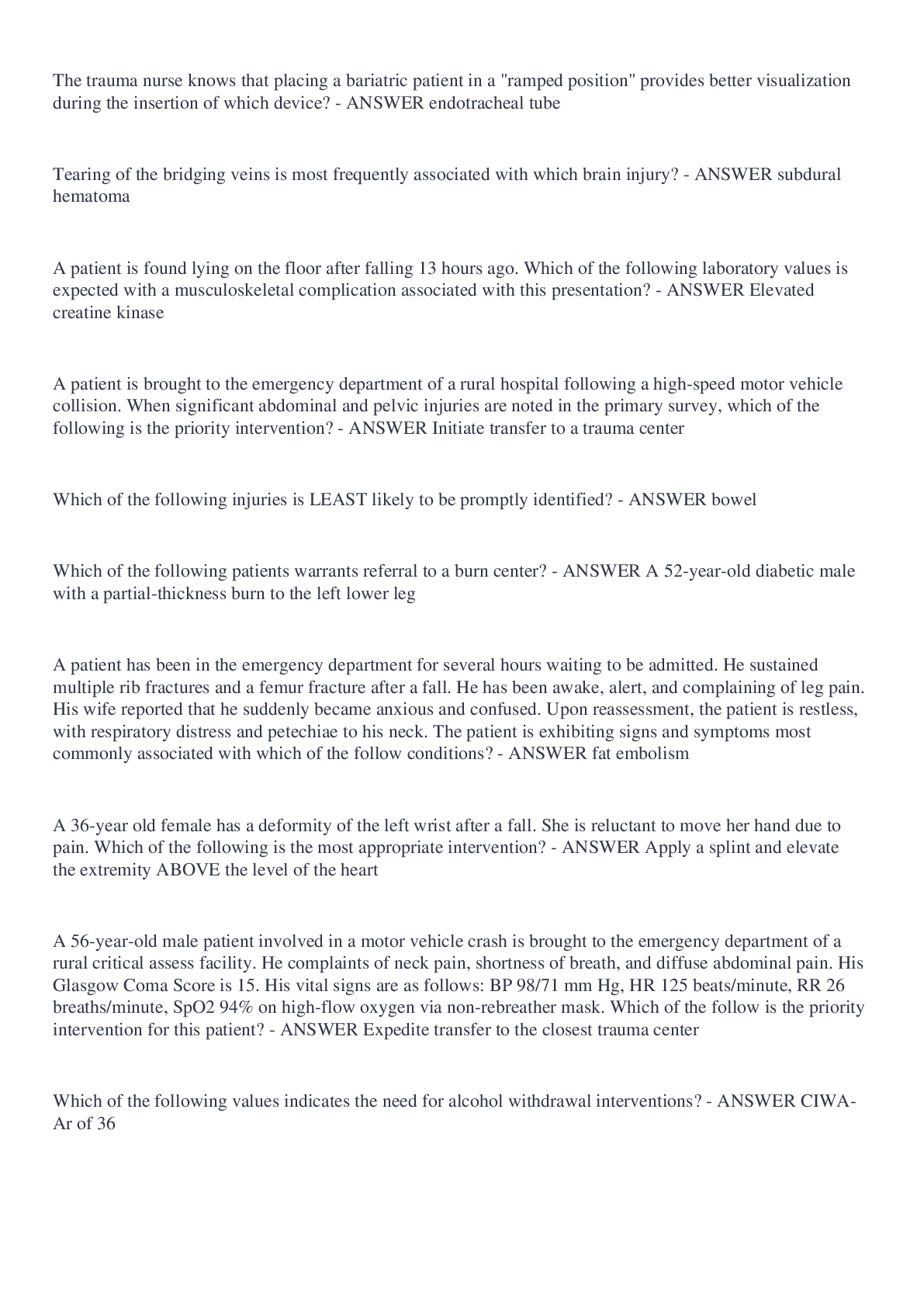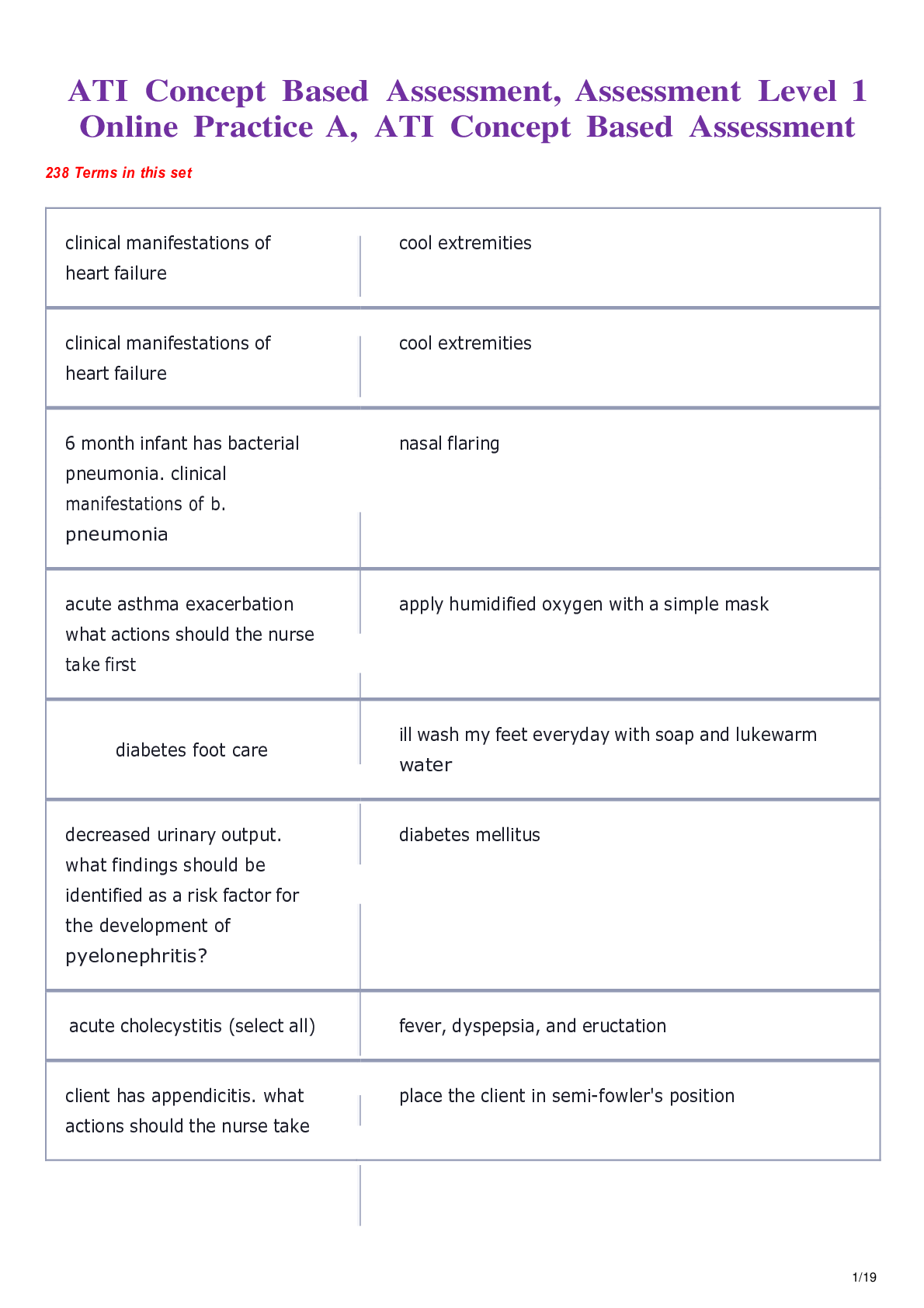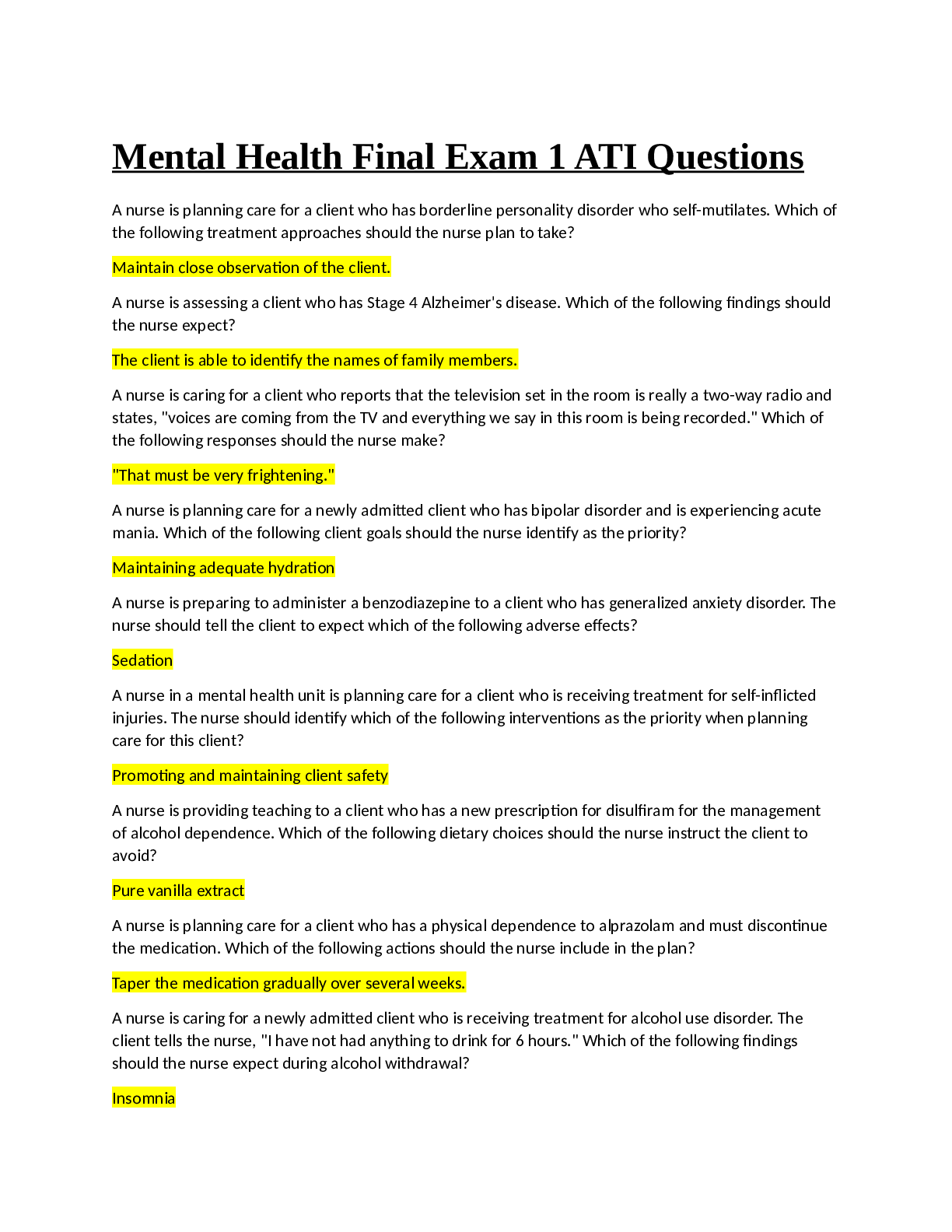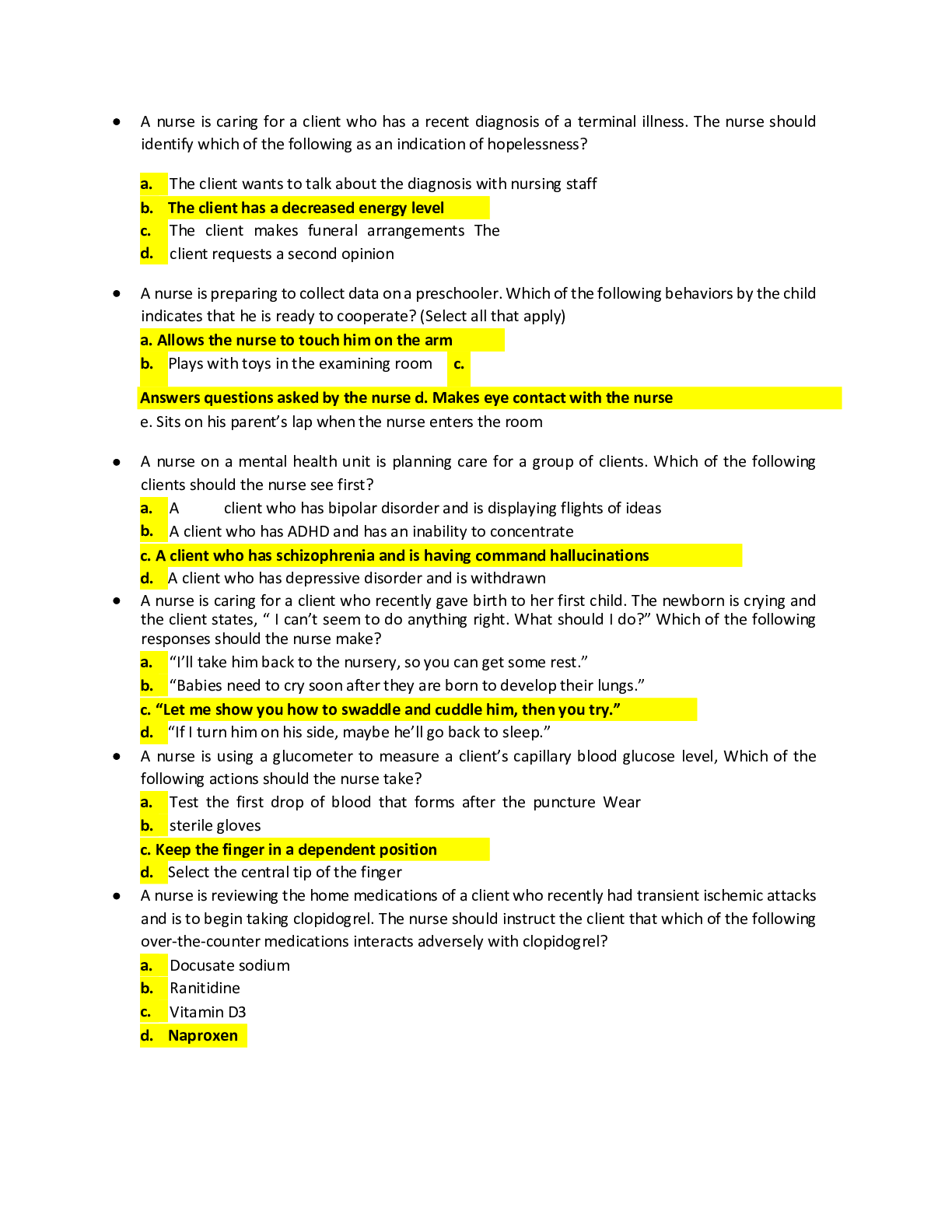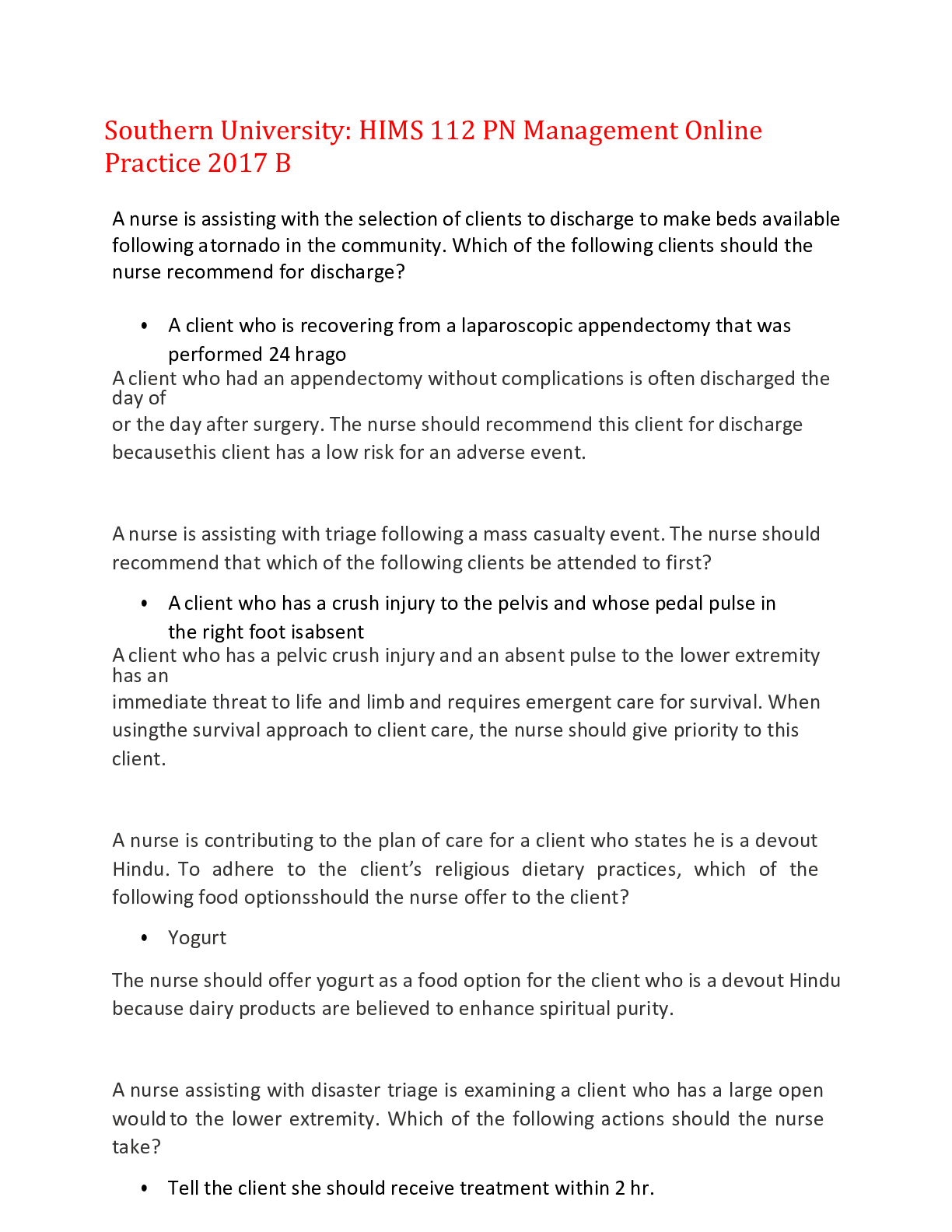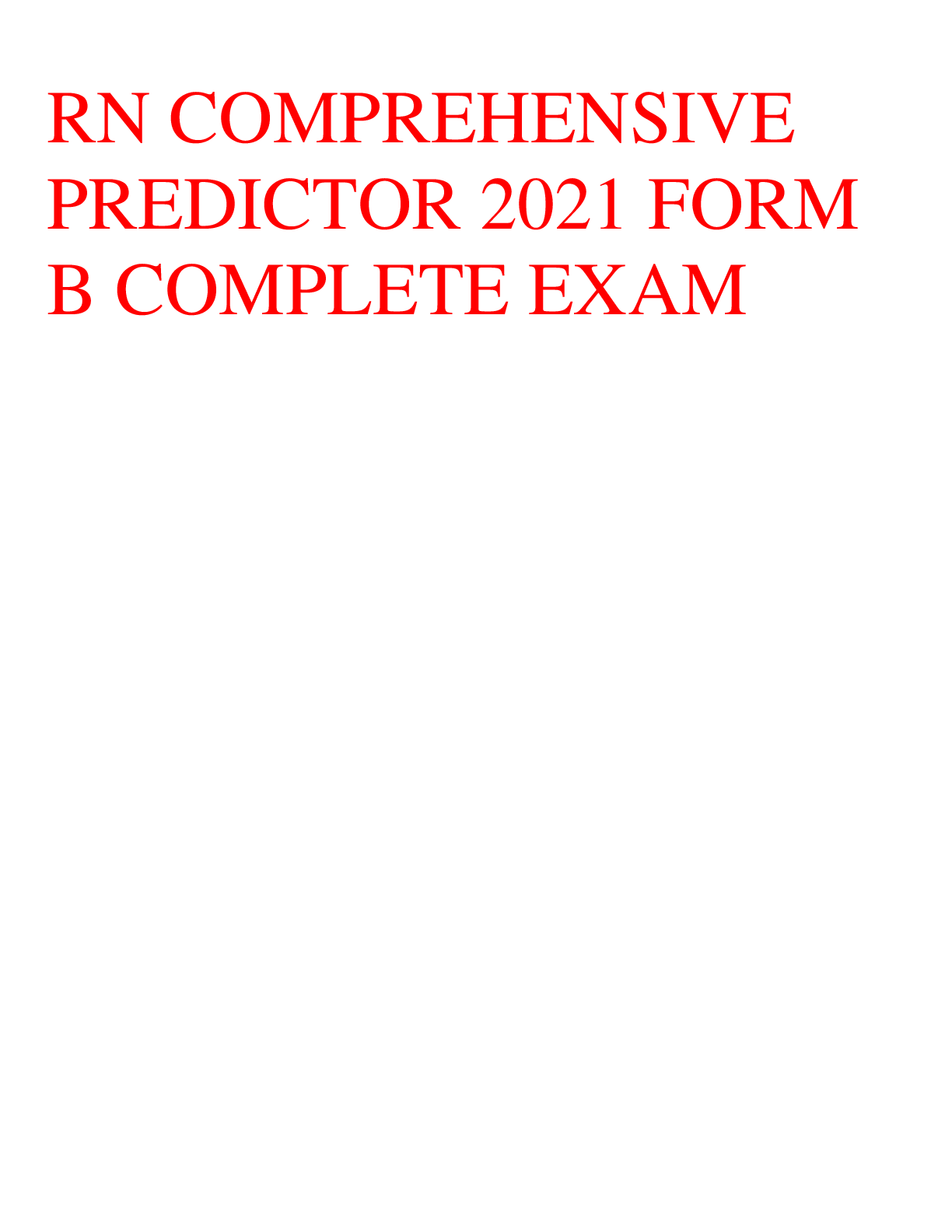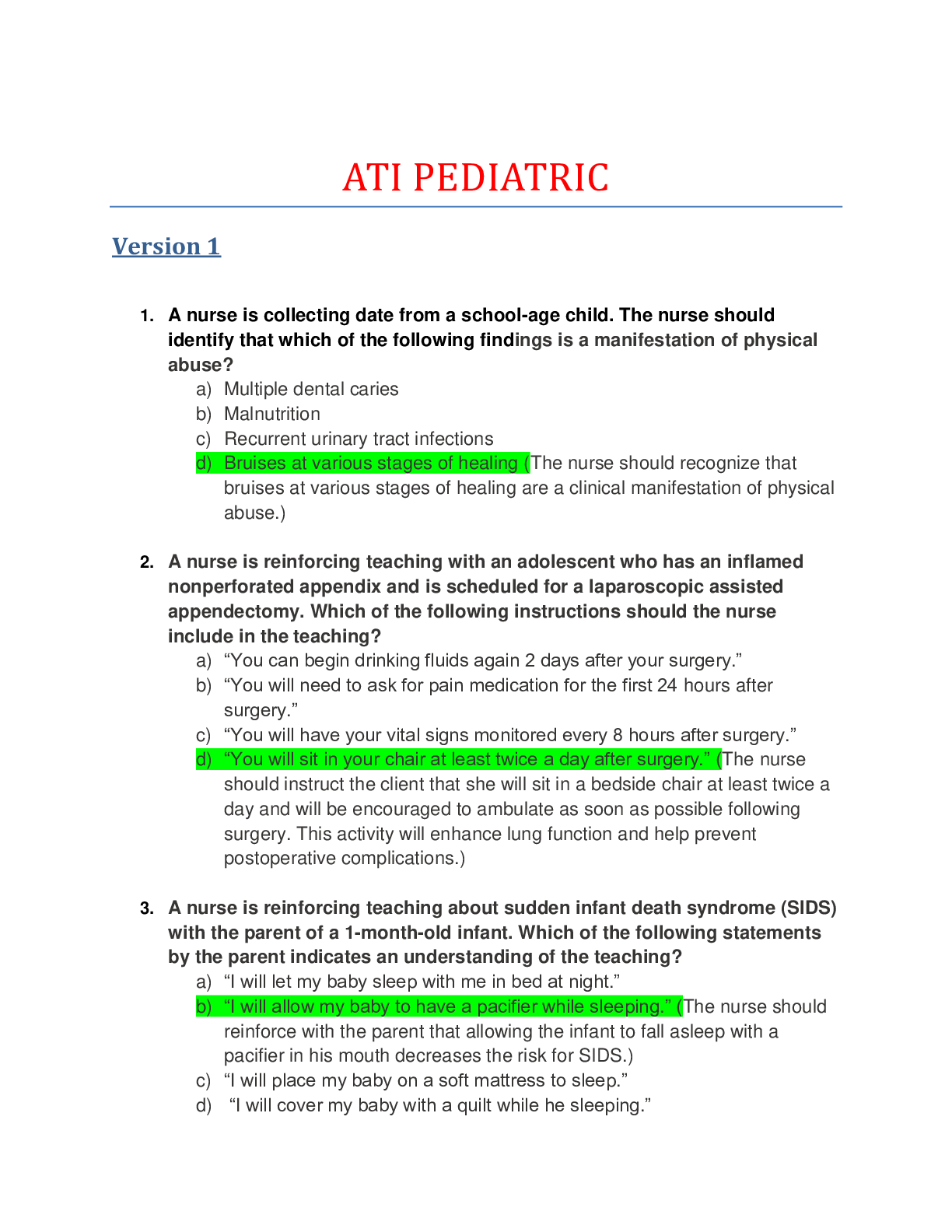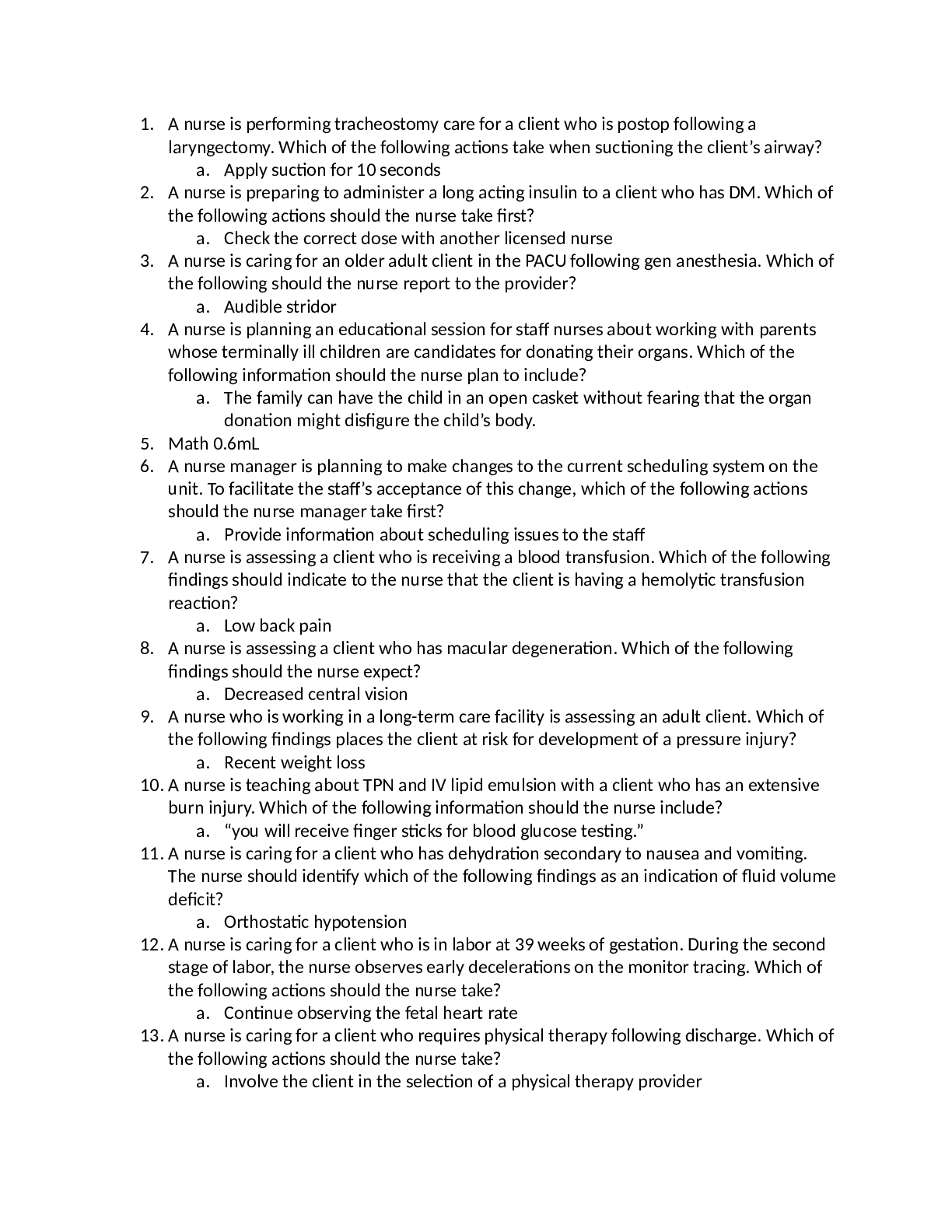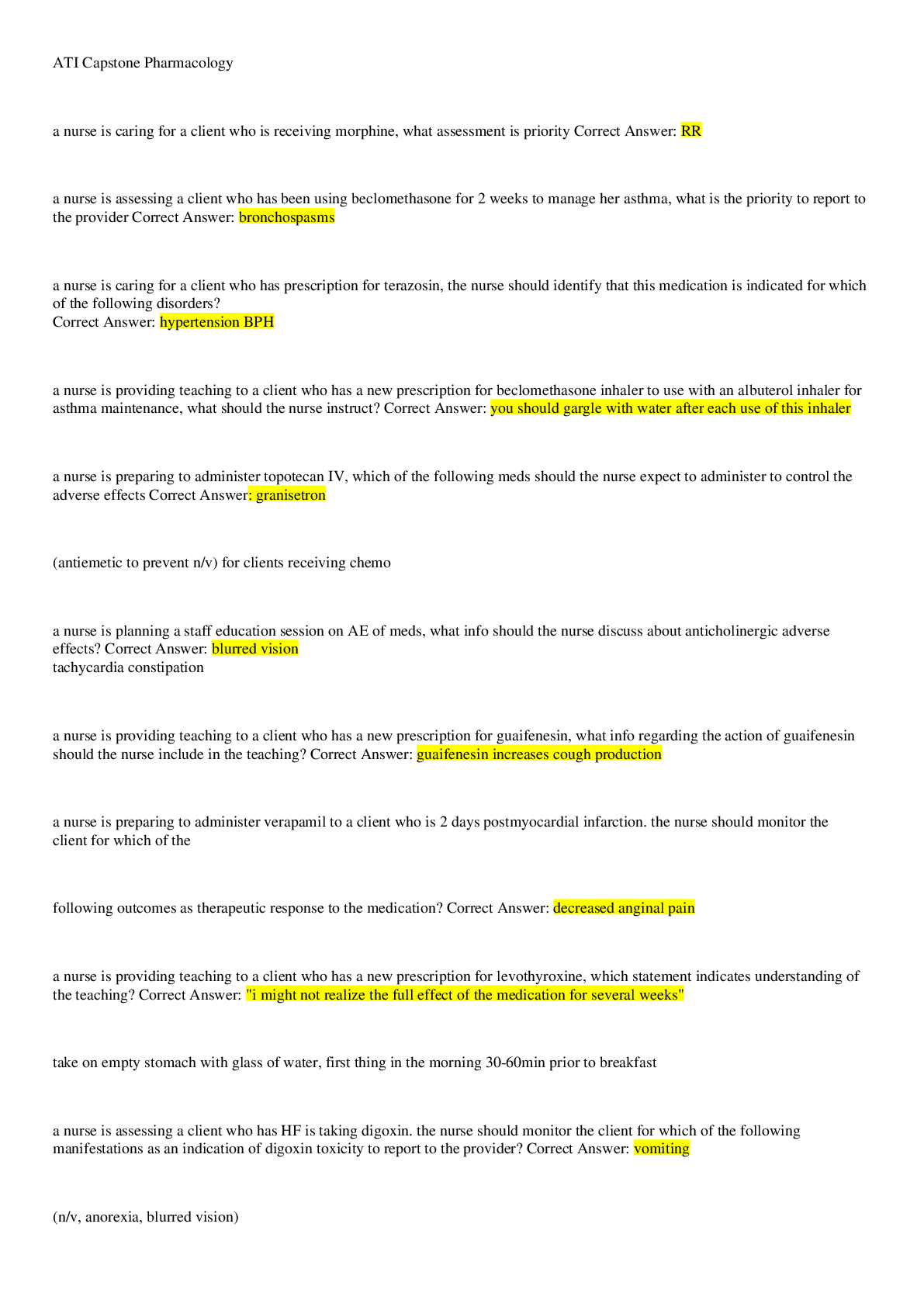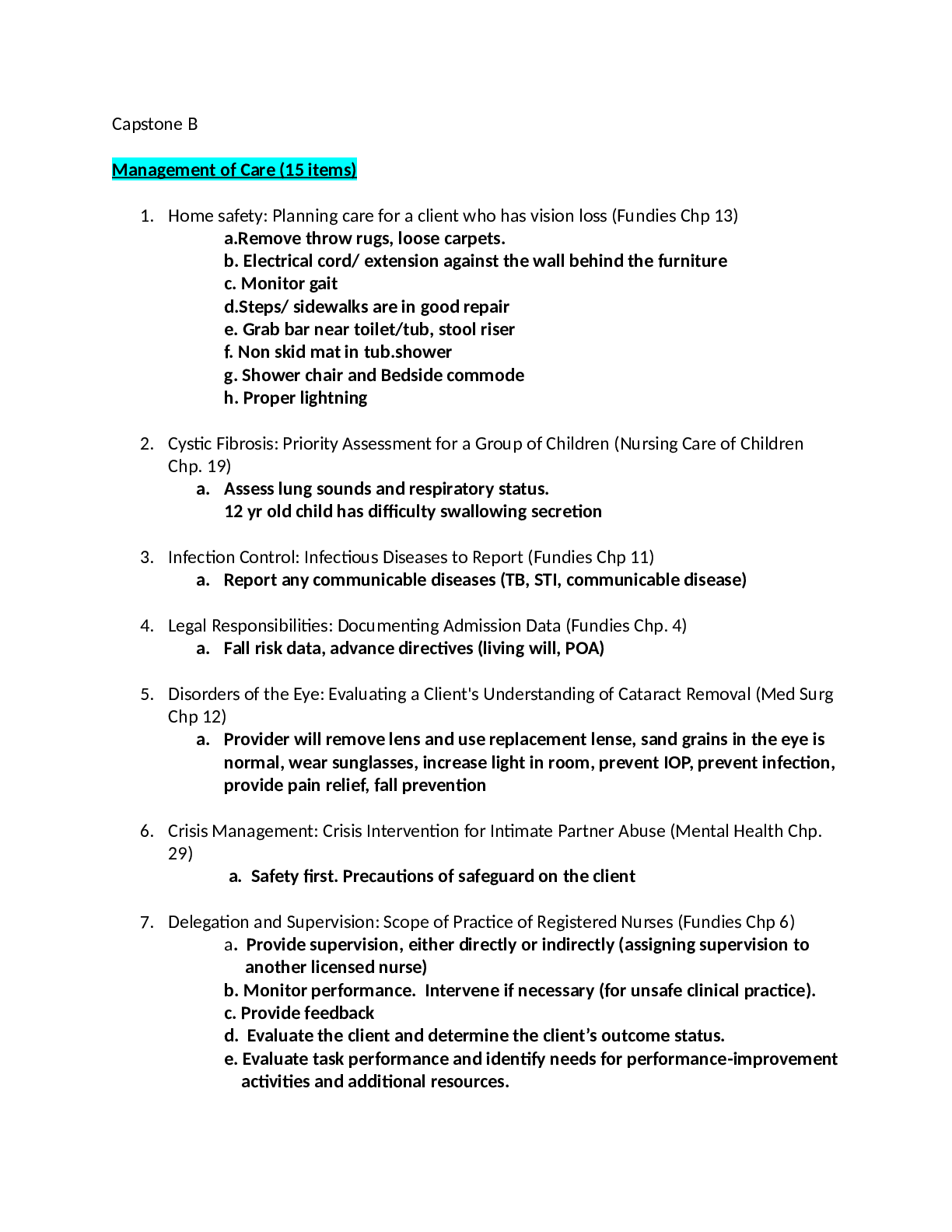*NURSING > QUESTIONS and ANSWERS > Zerwekh: Nursing Today, 6th Edition Test Bank_ Exam 2, latest complete questions and answers. (All)
Zerwekh: Nursing Today, 6th Edition Test Bank_ Exam 2, latest complete questions and answers.
Document Content and Description Below
Zerwekh: Nursing Today, 6th Edition Chapter 13: Conflict Management A newborn has several congenital anomalies incompatible with living beyond a month. He cannot retain formula, and his tem... perature drops when he is removed from the warmer. Two nurses who alternate caring for the baby argue about whether or not to attempt bottle feedings and whether he should be removed from the warmer to be held. What is the origin of the conflict described? a. Ethical values b. Nursing role concerns c. Personal goals for advancement d. Personality differences ANS: A This situation depicts personal issues based on two separate sets of ethics or values regarding the infant’s care. One nurse places value on nutritional needs and the other on the need for bonding. Of the following common areas of conflict between nurses and their clients and families, which is most easily resolved? a. Issues of concern about quality of care b. Issues surrounding treatment decisions c. Issues of family involvement d. Issues about quality of parental care ANS: A Families typically are concerned with how well their loved one is being attended to. Conflict often arises out of concerns related to quality of care. This is something that the nurse can directly address, whereas issues of treatment decisions, family involvement, and quality of parental care often require more discussion and intervention. What is the best strategy for resolving the conflict in a situation in which two staff nurses request the same vacation weeks? a. Accommodation b. Collaboration c. Competition d. Avoidance ANS: B Collaboration is the strategy that involves confrontation and problem solving. Needs, feelings, and desires of both parties are considered to create a win-win outcome. 4. On the unit in which you work, one nurse’s aide is usually pleasant and helpful; the other is often abrasive and angry. What is the most important basic guideline to be observed by a nurse who must resolve a conflict between the two nurse’s aides? a. Deal with issues, not personalities. b. Require the aides to reach a compromise. c. Weigh the consequences of each possible solution. d. Encourage ventilation of anger and use humor to minimize the conflict. He asks this question twice. ANS: A Dealing with the issues and not the personalities is one of seven important key behaviors in managing conflict. Issues tend to be more concrete, whereas personalities involve emotional issues. 5. One of your peers, a staff nurse, is a “potshot artist.” She often makes you the butt of innuendo or teasing digs. You are fed up and decide to take action the next time it happens. What strategy should be considered as an effective way of dealing with a “sniper”? a. Clam up and allow the individual to fully ventilate her concern. b. Confront the individual, saying that she is wrong. c. Coldly withdraw from the individual. d. Obtain group confirmation or denial of criticism raised by the individual. ANS: D When confronting the sniper, it is important to involve the rest of the staff to get a group consensus of denial or confirmation. 6. A staff nurse who has worked on the unit for 6 months voices the following concerns to another nurse: “The clinical nurse leader of the unit often follows me into the supply room, where she stands blocking the doorway and chats. She makes opportunities to mention my good looks, muscular physique, or strength in the context of daily work. She says things like, ‘You’re so handsome, no wonder your clients like you.’ As she talks to me, she frequently touches me on the arm, the shoulder, chest, or the hair, and if I’m sitting, she touches my leg. Yesterday, she patted my arm and said, ‘You know, if we were dating, I might be able to give you lighter assignments.’ I don’t want to date her. I just want her to leave me alone! What should I do?” What is the best reply? a. “Don’t be quite so honorable. Date her and see if you get better assignments.” b. “Confront her with a description of her behavior and tell her that you want her to stop.” c. “Go directly to the human relations office at the agency and tell them what you just told me.” d. “Contact your lawyer and get advice ASAP, in case she decides to turn the tables and accuse you of advances.” ANS: B There are two ways to deal with sexual harassment in the workplace: informally by confrontation and formally through a grievance procedure, keeping a record of all confrontations and statements in writing. The best first step is to confront the person directly. 7. When a nurse manager uses employment seniority to resolve a scheduling conflict between two nurses, this is an example of a: a. Win-win strategy b. Win-lose strategy c. Lose-lose strategy d. Compromise strategy ANS: C Avoidance is a lose-lose strategy for conflict resolution, which is unassertive and uncooperative. Both persons in the conflict essentially “lose,” because the decision is based on resorting to general rules instead of considering the merits of each of the individual cases, which would be more of a compromise. Win-win strategies involve collaboration and problem solving, which lead to cooperation and objectivity. 8. The nurse manager understands that the first step in attempting to resolve an interpersonal conflict between two nurses is to: a. Determine the facts related to the situation b. Schedule a meeting time for resolution c. Have an accurate understanding of the problem or conflict d. Have the determination to resolve the conflict ANS: C The quality of the outcome of resolving a problem depends on proper recognition and identification of the problem or issue. This assessment is best addressed by determining the nature of the differences and the reasons for them. After this has been achieved, the next steps would be identifying the conflicting facts and developing ways to implement a plan for resolution. 9. During a staff meeting, an upset nursing assistant tells the group that she thinks the other nursing assistants are given easier client assignments and are always given their choice of days off. What approach by the nurse manager would be effective to resolve this conflict? a. Attempt to persuade the upset nursing assistant to calm down. b. Tell the group that this type of conversation needs to be handled privately. c. Consider transferring the upset nursing assistant to another unit. d. Acknowledge the feelings of the upset nursing assistant and make a plan to meet with her. ANS: D Conflict negotiation requires dealing with issues, not personalities, by communicating openly, listening actively to the complaints, sorting out the issues, identifying key themes of the discussion, and weighing the consequences and options to resolve the conflict. Acknowledging the nursing assistant’s feelings is the first step in this process. 10. Considering the following terms used to label different styles of handling anger—the Sherman tank, the sniper, the constant complainer, and the clam—which of the following comments would you expect a Sherman tank to make? a. “That sure sounded like a put-down to me.” b. “How dare you accuse me of not putting away the linen!” c. “So, you think you know everything, eh?” d. “Why do we always have to rotate shifts?” ANS: B Sherman tanks attack individuals and have a strong need to prove to themselves and to others that their view of a situation is right. Their comments are abusive and abrupt and can be intimidating. Snipers take “pot shots” at others and are not as openly aggressive as Sherman tanks. Constant complainers do just that—they complain but offer no solution. Clams also behave like their name—they clam up and refuse to respond when you need an answer or want to talk. MULTIPLE RESPONSE 1. The staff nurse understands that which of the following are effective ways to deal with a sexual harassment issue in the workplace? Select all that apply. a. Tell the person to stop. b. Tell your best friend about the incident. c. File a formal grievance. d. Explain the situation to your spouse. e. Play along with the person and document the activities. f. Threaten the person with a sexual harassment lawsuit. ANS: A, B, C, D There are two ways to deal with sexual harassment workplace conflict: informally and formally through a grievance procedure. Start with the most direct measure. Ask the person to STOP! Tell the harasser in clear terms that the behavior makes you uncomfortable and that you want it to stop immediately. In addition, put your statement in writing to the person, keeping a copy for yourself. It is also important to tell other people (for example, family members, friends, your personal physician, your minister) that this is happening and how you are dealing with it. 2. Which of the following are common factors of conflict encountered in nursing? Select all that apply. a. Ambiguous boundaries around work responsibilities b. Unclear communication to family members about visiting hours c. Nursing assistant placing personal achievement above everything d. Chief of medicine demanding that the nurse/client ratio be increased e. Consideration of 26-week termination of pregnancy by a physician because of mother’s health f. Vacation schedules posted with new staff members having to work at least one day during all holidays ANS: A, B, C, D, E, F All of these areas are potential factors that can precipitate conflict in a nursing situation—roles, communication, goals, personalities, and conflicting ethics/values. (He doesn’t list all of them) Chapter 14: Delegation in the Clinical Setting MULTIPLE CHOICE 1. Which task could a staff nurse delegate to a certified nursing assistant (CNA)? a. Evaluating a client’s response to pain b. Making rounds with a physician c. Feeding a stroke client who has minimal dysphagia d. Assessing a client’s central venous line site ANS: C The majority of state boards have addressed the issue of delegation and have developed rules that offer specific guidelines regarding who can do what. The scope of practice for each level-of-care provider usually includes a description of the tasks that may be performed at that level. 2. The nurse has just given a client a narcotic for pain relief. Because the nurse must leave the unit for lunch and a 1-hour meeting, he must delegate the task of evaluating the client’s response to the pain medication. To whom should he delegate this responsibility? a. A nursing assistant b. A student nurse c. A licensed practical nurse d. A nurse manager ANS: D Many states are very specific in their description of what cannot be delegated and belongs only to the RN’s scope of practice. 3. The nurse has a full assignment. The charge nurse adds a newly admitted client who will require close monitoring. Which task can the nurse delegate to the CNA who is co-assigned to her clients? a. Teaching Mr. Z insulin self-administration b. Updating Mrs. W’s care plan c. Evaluating goal attainment for Mr. Y, who is learning to walk with a below-the-knee prosthesis d. Bathing Miss X, an unconscious client ANS: D The RN must determine what needs to be done and then identify whether this is a task that can be delegated to someone else. The roll of the RN involves the coordination and planning of care, with the primary focus on identifying with the client and the physician the desired outcomes for the clients. Bathing a client is within the role and responsibilities of the CNA. 4. Based on the goal of making optimal use of the level of preparation of the licensed practical nurse (LPN), which task should the RN delegate to the LPN? a. Assisting with a lumbar puncture b. Transporting a client to the radiology department c. Restocking the sterile supplies d. Passing afternoon nutrition supplements ANS: A The nurse must select the right task for a competent person in a selected situation. The other options can be carried out by a certified nursing assistant. 5. There is a temporary agency nurse assigned to the nursing unit. You have no knowledge of this nurse’s skills, and you want to assign the nurse to a client who has a fresh tracheostomy. How should you handle this situation? a. Assign the nurse to the client with the tracheostomy and hope for the best. b. Ask the nurse about her competency to care for the client with the tracheostomy. c. Assign the client to another nurse and use the temporary agency nurse to do simple care tasks. d. Call the agency and ask for a nurse skilled in the care of a client with a tracheostomy. ANS: B Float and temporary nurses should be asked about their competency at the beginning of a shift or assignment. Delegation of an activity should always be followed by an anticipated response from that nurse as to whether or not he or she feels capable of performing the task. It is important to determine the competency of the nurse as well as to make sure the nurse indicates she or he is competent to carry out the delegated activity. 6. What would be the best example of delegation? a. Transferring to another RN the responsibility of caring for a client requiring a blood transfusion b. Providing guidance to an LPN to hang blood on a client c. Assigning a series of nursing unit tasks to the certified nursing assistant d. Assisting a new nurse to understand the rules and regulations of the Nurse Practice Act ANS: A Delegation involves transferring to a competent nurse a specific task or responsibility for nursing care. The person who delegated the responsibility maintains responsibility for following guidelines for appropriate delegation. 7. What would be the best example of supervision? a. Assigning nursing care for a group of five clients to an RN b. Following up with a CNA on the assigned task of ambulation and feeding of two clients c. Assigning a urinary catheterization and collection of sterile culture to an LPN d. Scheduling the LPN to administer medications on the unit for the afternoon ANS: B Supervision is the provision of guidance, direction, and follow-up for the accomplishment of an assigned task. The nurse would follow up with the CNA to determine whether the tasks were completed and whether any problems occurred. 8. What are potential causes of performance inadequacies? a. The person to whom the task was assigned had appropriate educational qualifications to complete the task. b. The task was assigned to a person capable of carrying out the assignment. c. The person who delegated the task confirmed the recipient’s ability to perform the task. d. The person to whom the task was assigned did not understand what the task involved. ANS: D Principles of delegation—the person to whom the task is assigned should verify that he or she understands and can perform the task. 9. Which of the following represents appropriate feedback for an assignment to an LPN? a. “Did you understand the assignment that you received in the staff report?” ****************CONTINUED************** [Show More]
Last updated: 1 year ago
Preview 1 out of 53 pages
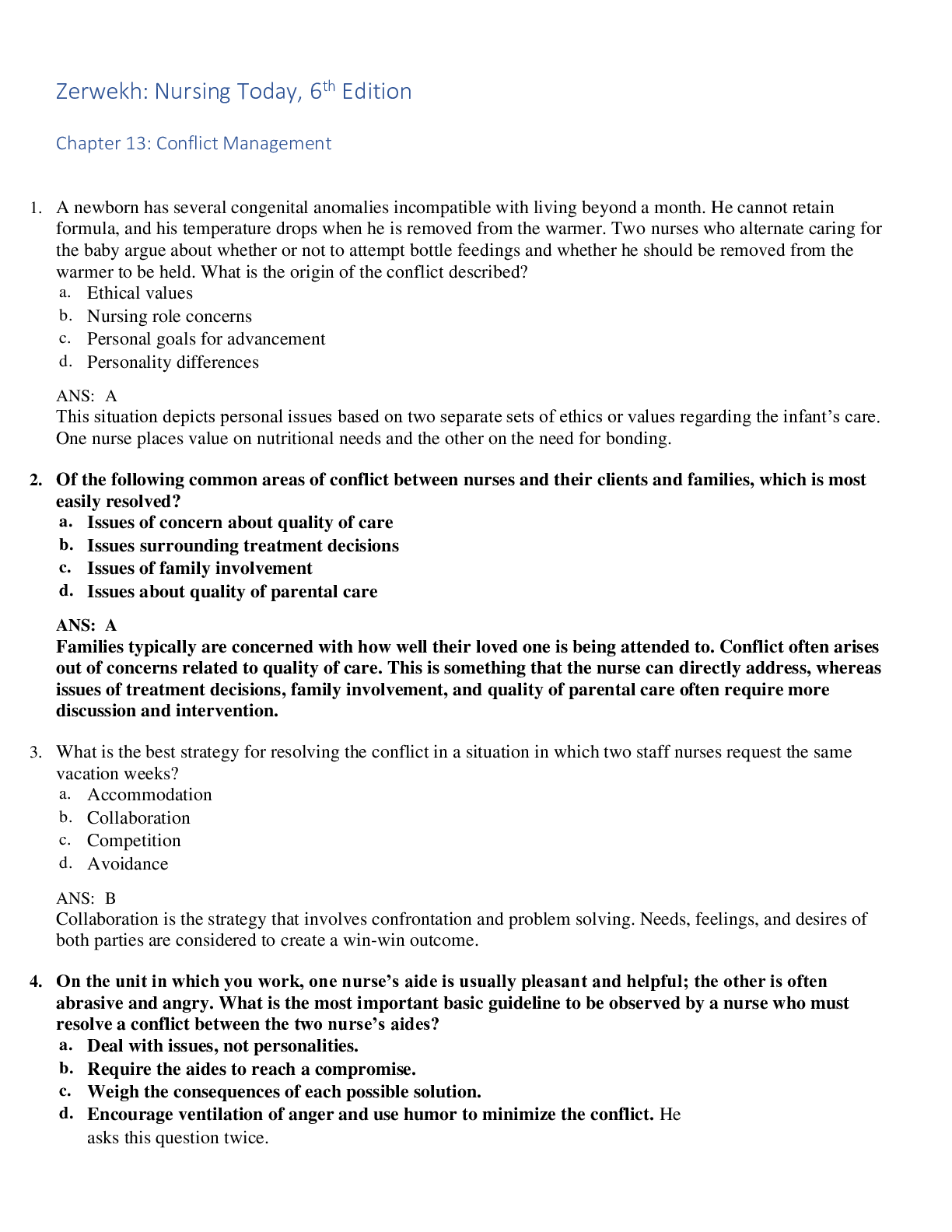
Reviews( 0 )
Document information
Connected school, study & course
About the document
Uploaded On
Oct 10, 2020
Number of pages
53
Written in
Additional information
This document has been written for:
Uploaded
Oct 10, 2020
Downloads
0
Views
51

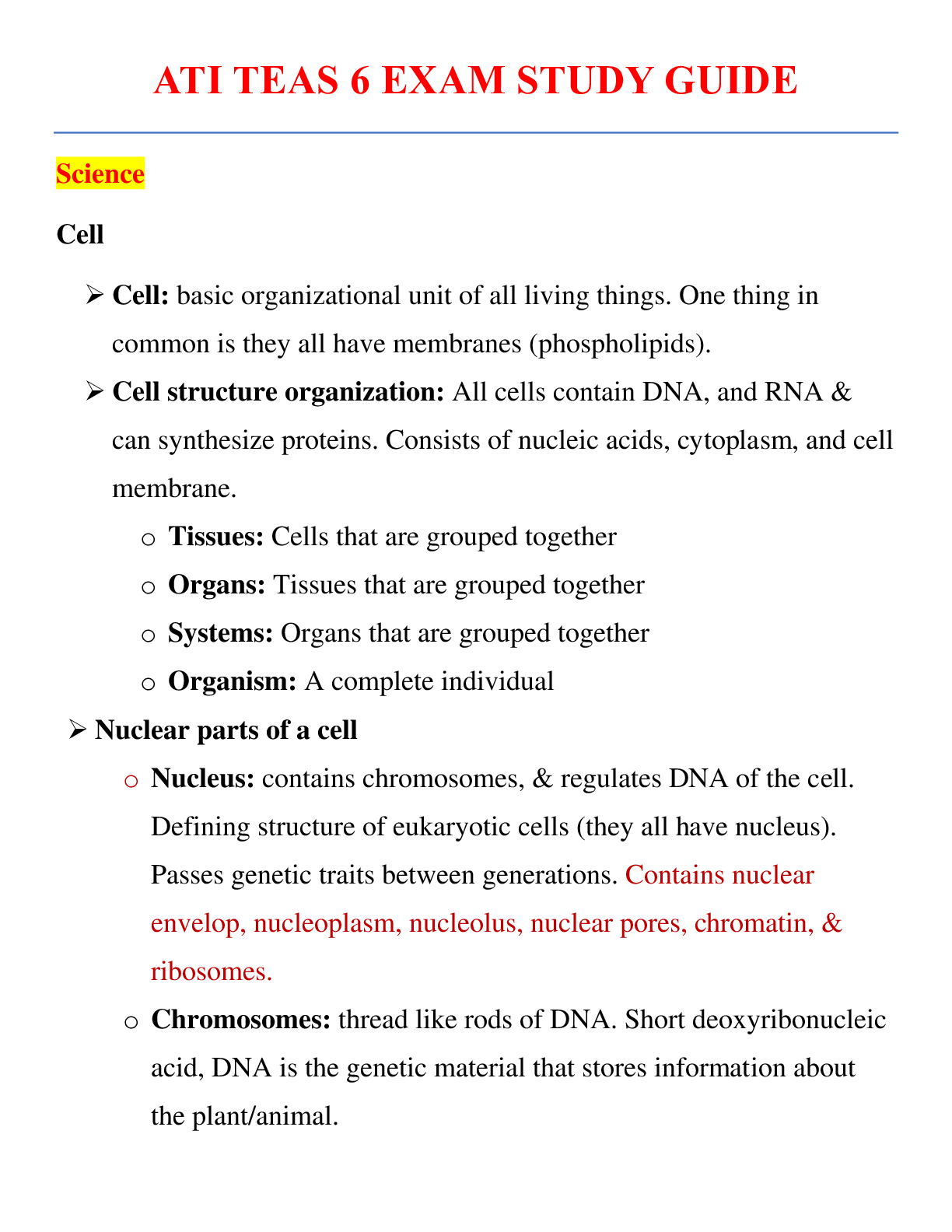

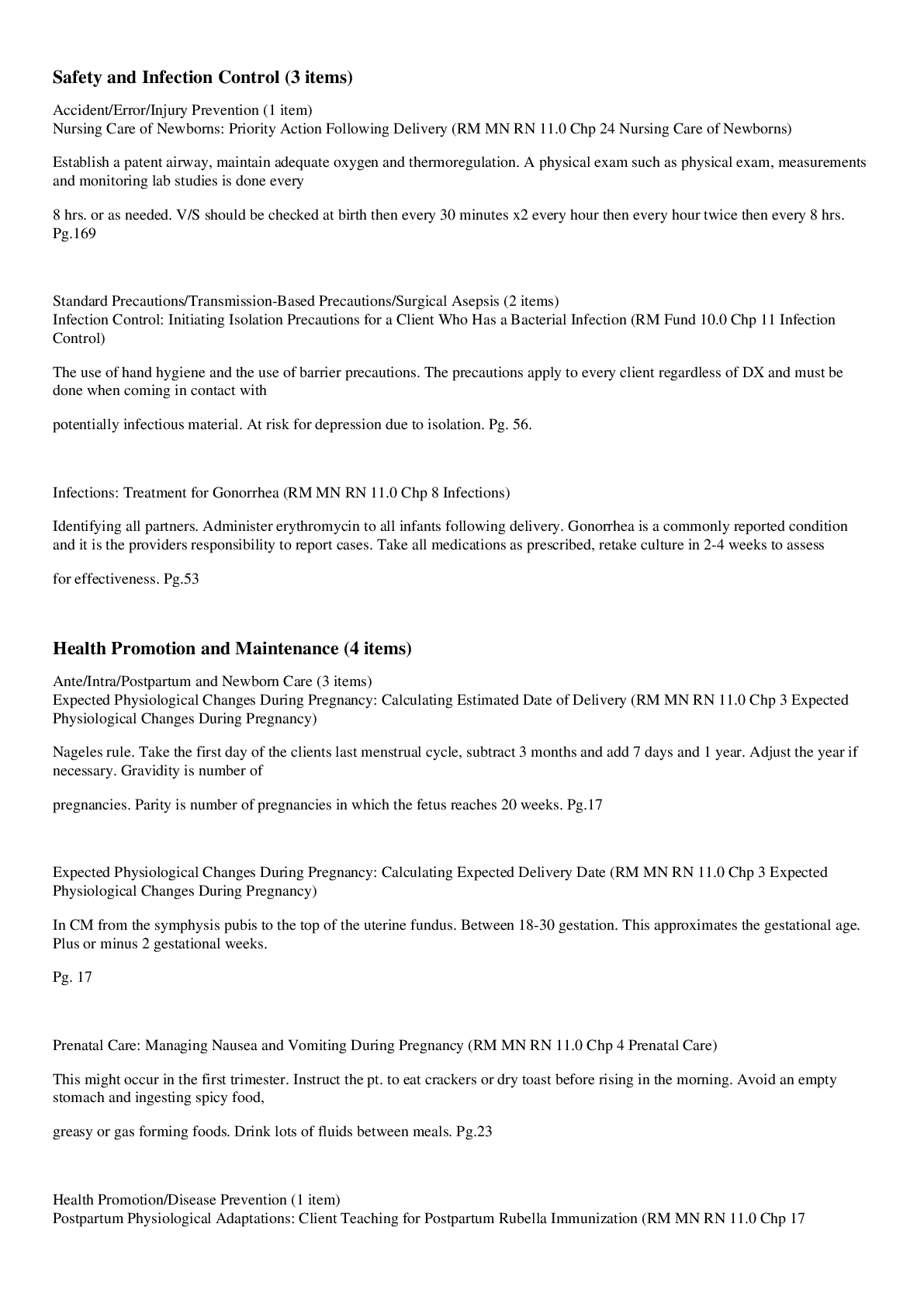
.png)
